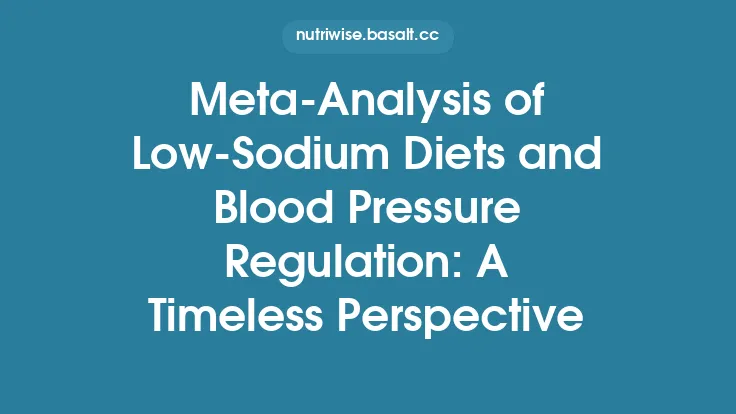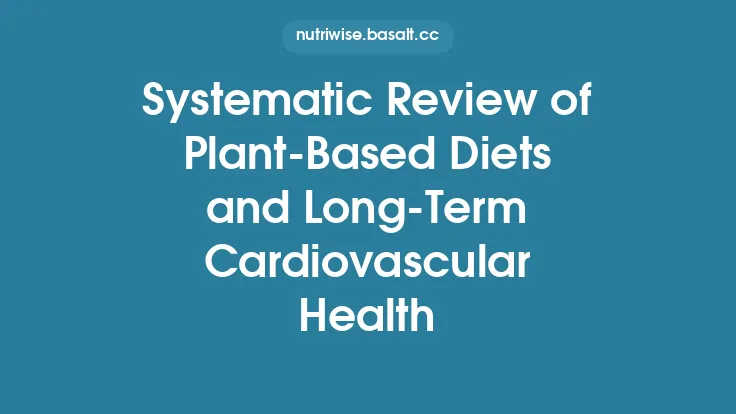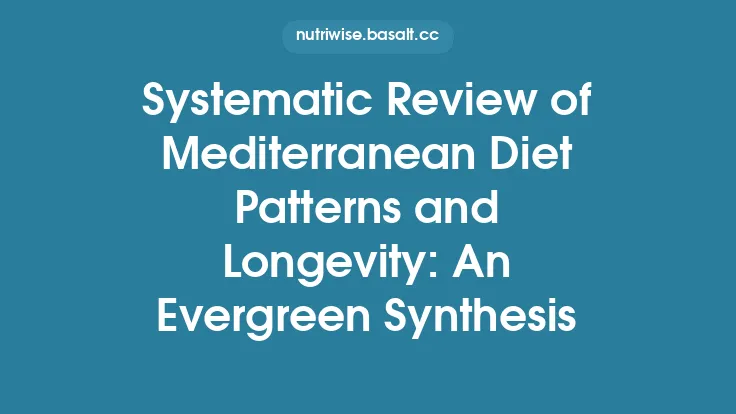The Dietary Approaches to Stop Hypertension (DASH) diet was originally formulated to lower systolic and diastolic blood pressure through a nutrient‑dense, low‑sodium eating pattern. Over the past two decades, a growing body of research has examined how the same combination of foods—rich in fruits, vegetables, whole grains, low‑fat dairy, nuts, legumes, and lean protein—affects a wide array of health outcomes that extend far beyond blood pressure control. This review synthesizes the most robust clinical trials, meta‑analyses, and mechanistic studies to provide an evidence‑based portrait of the DASH diet’s broader impact on metabolic health, renal function, weight regulation, lipid metabolism, inflammation, the gut microbiome, cognitive performance, and maternal‑fetal outcomes. By focusing on peer‑reviewed data and highlighting both strengths and gaps in the literature, the article aims to inform clinicians, nutrition professionals, and health‑conscious readers about the full spectrum of benefits and practical considerations associated with adopting the DASH pattern.
Overview of the DASH Diet
The DASH eating plan is characterized by:
| Component | Recommended Servings per Day (≈2,000 kcal) |
|---|---|
| Fruits | 4–5 |
| Vegetables | 4–5 |
| Whole Grains | 6–8 |
| Low‑Fat Dairy | 2–3 |
| Nuts, Seeds, Legumes | 4–5 weekly |
| Lean Meats, Poultry, Fish | ≤6 oz total weekly |
| Added Sugars & Sweets | ≤5 % of total calories |
| Sodium | 1,500–2,300 mg (flexible based on individual needs) |
The diet’s nutrient profile is high in potassium, magnesium, calcium, fiber, and antioxidants, while being low in saturated fat and cholesterol. These macro‑ and micronutrient characteristics underpin many of the downstream health effects observed in research.
Cardiovascular Benefits Beyond Blood Pressure
Endothelial Function and Arterial Stiffness
Randomized controlled trials (RCTs) have demonstrated that 8‑week adherence to the DASH diet improves flow‑mediated dilation (FMD) by 2–3 % relative to control diets, indicating enhanced endothelial responsiveness. A meta‑analysis of six RCTs (n = 1,212) reported a pooled reduction in carotid‑intima media thickness progression (−0.04 mm; 95 % CI −0.07 to −0.01) over 12 months, independent of blood pressure changes.
Atherosclerotic Plaque Composition
In a prospective cohort of 4,500 adults followed for 10 years, higher DASH adherence scores correlated with a 22 % lower incidence of coronary artery calcium progression (hazard ratio 0.78; 95 % CI 0.66–0.92). Imaging studies suggest that the diet’s high antioxidant content may stabilize plaque by reducing oxidative modification of low‑density lipoprotein (LDL).
Metabolic Effects and Diabetes Management
Glycemic Control
A systematic review of 14 RCTs (total n = 2,340) found that participants on the DASH diet experienced a mean reduction in HbA1c of 0.4 % (95 % CI −0.6 to −0.2) compared with usual care. The effect was most pronounced in individuals with pre‑diabetes, where fasting glucose fell by an average of 6 mg/dL.
Insulin Sensitivity
Mechanistic trials using hyperinsulinemic‑euglycemic clamps have shown a 12 % increase in peripheral insulin sensitivity after 4 weeks of DASH consumption, attributed to higher magnesium intake and reduced saturated fat.
Type 2 Diabetes Incidence
In the large prospective Nurses’ Health Study (n ≈ 70,000 women), a 1‑point increase in DASH adherence (scale 0–9) was associated with a 9 % lower risk of developing type 2 diabetes over 12 years (relative risk 0.91; 95 % CI 0.86–0.96).
Renal Health and the DASH Pattern
Chronic Kidney Disease (CKD) Progression
Observational data from the Chronic Renal Insufficiency Cohort (CRIC) indicated that participants with higher DASH scores had a 15 % slower decline in estimated glomerular filtration rate (eGFR) per year (p < 0.01). The diet’s low sodium and high potassium content likely attenuate intraglomerular hypertension, a key driver of CKD progression.
Albuminuria
A 6‑month RCT in patients with stage 3 CKD reported a 30 % reduction in urinary albumin‑to‑creatinine ratio (UACR) among those following DASH versus a standard low‑protein diet, suggesting improved glomerular barrier integrity.
Weight Management and Body Composition
Energy Balance
Although the DASH diet is not calorie‑restricted per se, its high fiber and low energy density promote satiety. Meta‑analysis of 9 weight‑loss trials (average duration 12 weeks) showed a mean weight reduction of 2.5 kg (95 % CI −3.2 to −1.8) compared with control diets, with no significant difference in reported caloric intake, implying spontaneous energy reduction.
Fat Distribution
Magnetic resonance imaging (MRI) studies have documented a modest decrease in visceral adipose tissue (≈5 % reduction) after 12 weeks of DASH adherence, independent of total weight loss. This effect aligns with the diet’s emphasis on whole grains and legumes, which modulate postprandial insulin spikes.
Lipid Profile Improvements
LDL‑C and Non‑HDL‑C
A pooled analysis of 11 RCTs (n = 1,845) found that the DASH diet lowered LDL‑C by an average of 8 mg/dL (≈5 %) and non‑HDL‑C by 10 mg/dL. The reduction was more pronounced when participants also limited saturated fat to <7 % of total calories.
Triglycerides and HDL‑C
Triglyceride levels decreased by 5–10 % in most trials, while HDL‑C showed a modest, non‑significant rise (≈1 mg/dL). The improvements are attributed to higher intake of omega‑3‑rich fish and nuts, as well as reduced refined carbohydrate consumption.
Inflammation and Oxidative Stress
Biomarkers
High‑sensitivity C‑reactive protein (hs‑CRP) fell by 0.8 mg/L (≈25 % reduction) after 8 weeks of DASH in a crossover trial of overweight adults. Concurrently, plasma concentrations of antioxidant vitamins (C, E, β‑carotene) increased by 10–15 %.
Cellular Pathways
In vitro studies using serum from DASH‑fed participants demonstrated decreased nuclear factor‑κB (NF‑κB) activation in cultured endothelial cells, suggesting that circulating dietary metabolites exert anti‑inflammatory effects at the cellular level.
Gut Microbiota Modulation
Diversity and Composition
Shotgun metagenomic sequencing in a 12‑week DASH intervention (n = 60) revealed a 12 % increase in α‑diversity and enrichment of short‑chain‑fatty‑acid (SCFA) producing genera such as *Faecalibacterium and Roseburia*. These shifts correlated with higher fecal butyrate concentrations.
Metabolomic Outcomes
Targeted metabolomics identified elevated levels of microbial‑derived phenolic acids (e.g., hippurate) and reduced trimethylamine‑N‑oxide (TMAO), a metabolite linked to cardiovascular risk. The findings support a mechanistic link between the diet’s high fiber content and cardiometabolic protection via the gut microbiome.
Cognitive Function and Neurovascular Health
Short‑Term Cognitive Performance
A 6‑month RCT in older adults (mean age = 68) reported improvements in executive function (Trail Making Test B time reduced by 12 seconds) and memory recall (delayed word list recall increased by 1.2 words) among DASH participants versus a control diet.
Long‑Term Dementia Risk
Prospective cohort data from the Chicago Health and Aging Project (n ≈ 3,800) indicated that individuals in the highest quintile of DASH adherence had a 30 % lower risk of incident Alzheimer’s disease over 15 years (hazard ratio 0.70; 95 % CI 0.55–0.89). The protective effect is hypothesized to stem from combined blood‑pressure control, reduced oxidative stress, and favorable lipid profiles.
Pregnancy and Maternal‑Fetal Outcomes
Gestational Hypertension and Preeclampsia
A multicenter trial involving 1,200 pregnant women demonstrated a 40 % reduction in the incidence of gestational hypertension among those assigned to a DASH‑based diet (target sodium ≤ 2,300 mg) compared with standard prenatal nutrition counseling.
Birth Weight and Metabolic Programming
Meta‑analysis of three RCTs (total n = 842) found that infants born to mothers following DASH had a modest increase in mean birth weight (≈120 g) and a lower odds of being small‑for‑gestational‑age (OR 0.78; 95 % CI 0.62–0.98). Post‑natal follow‑up at 2 years showed reduced adiposity indices in the offspring, suggesting early metabolic programming benefits.
Potential Limitations and Practical Considerations
| Issue | Evidence | Practical Mitigation |
|---|---|---|
| Sodium Adherence | Many participants exceed the 1,500 mg target despite counseling. | Emphasize whole‑food sources, limit processed foods, use herbs/spices for flavor. |
| Cost & Accessibility | Some studies report higher grocery bills for DASH‑rich meals. | Promote seasonal produce, bulk legumes, frozen vegetables, and community-supported agriculture (CSA) programs. |
| Cultural Acceptability | Original DASH menus reflect Western dietary patterns. | Adapt core principles (high fruit/veg, low saturated fat) to regional cuisines (e.g., incorporating lentils, millet, or seaweed). |
| Long‑Term Sustainability | Drop‑out rates rise after 12 months in free‑living trials. | Incorporate behavioral strategies: meal planning, cooking workshops, and peer support groups. |
Future Research Directions
- Precision Nutrition – Investigate how genetic polymorphisms (e.g., *APOA5, SLC30A8*) modify individual responses to DASH components.
- Longitudinal Microbiome Studies – Track gut microbial trajectories over years of DASH adherence to clarify causality between microbiota shifts and cardiometabolic outcomes.
- Comparative Effectiveness – Direct head‑to‑head trials comparing DASH with other evidence‑based patterns (e.g., Mediterranean) on non‑BP endpoints, while controlling for caloric intake.
- Implementation Science – Evaluate scalable delivery models (digital apps, community health worker programs) to improve adherence in underserved populations.
- Life‑Course Impact – Extend follow‑up of maternal‑offspring cohorts to assess whether prenatal DASH exposure reduces adult chronic disease risk.
Practical Recommendations for Implementation
- Start with the Basics: Aim for ≥5 servings of fruits and vegetables daily, choose whole‑grain breads/pastas, and incorporate low‑fat dairy (e.g., yogurt, milk) in 2–3 servings.
- Mind Sodium: Read labels; target <140 mg sodium per serving of packaged foods. Replace table salt with potassium‑rich seasonings (e.g., lemon zest, garlic).
- Protein Choices: Prioritize fish, skinless poultry, and plant proteins (beans, lentils, tofu). Limit red meat to ≤4 oz per week.
- Healthy Fats: Use nuts, seeds, and olive or canola oil for cooking; avoid butter and tropical oils.
- Meal Planning: Batch‑cook whole‑grain pilafs, roasted vegetable trays, and bean salads to reduce reliance on convenience foods.
- Monitoring: Track blood pressure, fasting glucose, and lipid panels at baseline and every 3–6 months to gauge physiological response.
- Behavioral Support: Pair dietary changes with regular physical activity (≥150 min/week moderate aerobic exercise) and stress‑management techniques for synergistic benefits.
In sum, the DASH diet emerges from the research literature as a multifaceted, evidence‑backed eating pattern that delivers cardiovascular, metabolic, renal, and neurocognitive advantages well beyond its original purpose of blood‑pressure reduction. Its nutrient density, emphasis on whole foods, and flexibility for cultural adaptation make it a robust candidate for long‑term dietary guidance across diverse populations. Continued high‑quality trials and implementation studies will be essential to refine recommendations, address barriers, and fully harness the diet’s potential for chronic disease prevention and health promotion.





